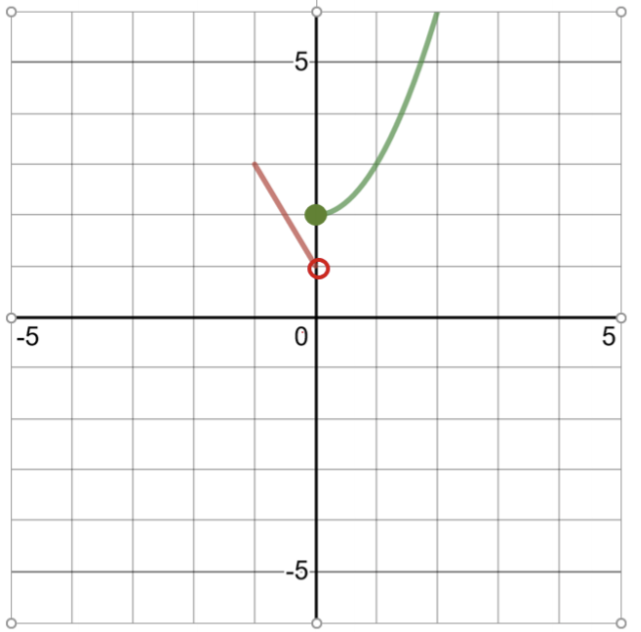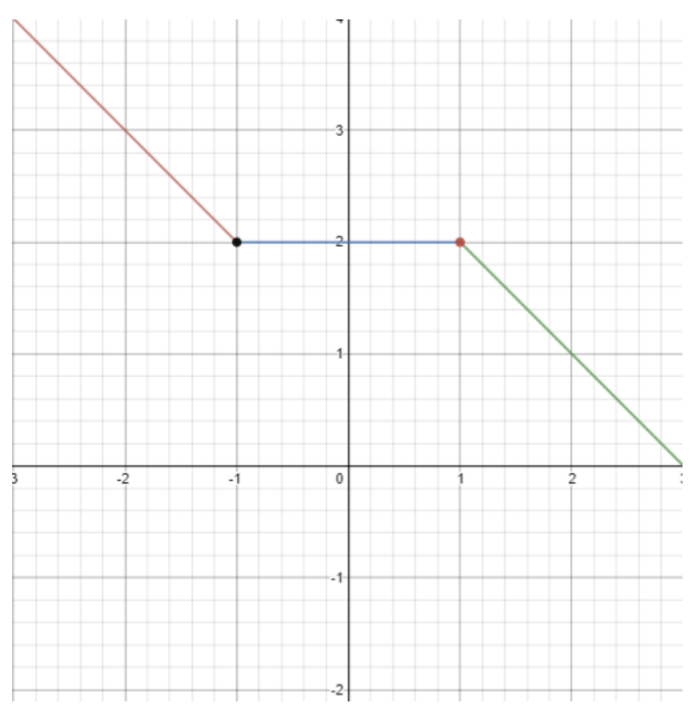4.11: Funciones de definición a trozos
- Page ID
- 112500
Las funciones definidas por partes son funciones que se definen usando diferentes ecuaciones para diferentes partes del dominio.
Evalúe la siguiente función definida por partes para los valores dados de\(x\), y grafique la función:
\(f(x) = \left\{\begin{array}{cc}−2x + 1 & −1 \leq x < 0 \\ x^2 + 2 &0 \leq x \leq 2\end{array} \right.\)
Solución
Para graficar esta función, haz una tabla de soluciones:
|
Tabla de soluciones para\(f(x) = −2x + 1 \) Dominio\(−1 \leq x < 0\) |
|
| \(x\) | \(f(x)\) |
| -1 | 3 |
| 0 | 1 (círculo abierto aquí, 0 no en el dominio) |
|
Tabla de soluciones para\(f(x) = x^2 + 2\) Dominio\(0 \leq x \leq 2\) |
|
| \(x\) | \(f(x)\) |
| 0 | 2 |
| 1 | 3 |
| 2 | 6 |

Evalúe la siguiente función definida por partes para los valores dados de\(x\), y grafique la función:
\(f(x) = \left\{\begin{array}{cc} −x + 1 &x \leq −1 \\ 2 & −1 < x \leq 1 \\ −x + 3 &x > 1 \end{array}\right.\)
Solución
Para graficar esta función, una vez más haga una tabla de soluciones:
|
Tabla de soluciones para\(f(x) = −x + 1\) Dominio\(x \leq −1\) |
|
| \(x\) | \(f(x)\) |
| -3 | 4 |
| -2 | 3 |
| -1 | 2 (círculo cerrado aquí, -1 está en el dominio) |
|
Tabla de soluciones para\(f(x) = 2\) Dominio\(−1 < x \leq 1\) |
|
| \(x\) | \(f(x)\) |
| -1 | 2 (círculo abierto rellenado por la función anterior, -1 no en el dominio) |
| 0 | 2 |
| 1 | 2 (círculo cerrado aquí, 1 está en el dominio) |
|
Tabla de soluciones para\(f(x) = −x + 3\) Dominio\(x > 1\) |
|
| \(x\) | \(f(x)\) |
| 1 | 2 (círculo abierto rellenado por la función anterior, 1 no en el dominio) |
| 2 | 1 |
| 3 | 0 |

Evaluar las siguientes funciones definidas por partes para los valores dados de x, y graficar las funciones:.
- \ (f (x) =\ left\ {\ begin {array} {cc}
x & x<0\\
2 x+1 &x\ geq 0
\ end {array}\ right.\) - \(g(x) = \left\{\begin{array}{cc} 4 − x& x < 2\\ 2x − 2 &x \geq 2 \end{array} \right.\)
- \(h(x) = \left\{\begin{array}{cc} −x − 1 & x < −1 \\ 0& −1 \leq x \leq 1 \\ x + 1 & x > 1 \end{array} \right.\)
- \(g(x) = \left\{\begin{array}{cc} 6 & −8 \leq x < −4 \\ 3 &−4 \leq x \leq 5 \end{array}\right.\)
- \(f(x) = \left\{\begin{array}{cc} −x + 1 & −1 \leq x < 1 \\ \sqrt{x − 1 } &1 \leq x \leq 5\end{array}\right.\)


